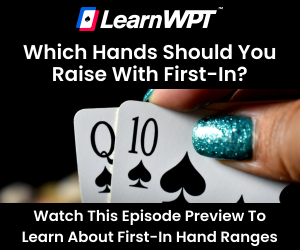Poker Quiz! T♠9♠ Facing a 3-Bet, What Do You Do Here?
DECISION POINT: You are the middle stages of a large field live tournament where binds are 400/800 with a 800 big blind ante. There are a variety of stack sizes at the table ranging from around 20 big blinds to over 100BBs, and you have 60BBs. You raise to 2,000 from UTG+1 with T♠9♠ and get called by MP1, Hijack, and the Button. The Small Blind folds, the Big Blind 3-bets to 8,800 and action is on you.
What do you do here?
PRO ANSWER: We are in the middle stages of a large field live tournament. The blinds are 400/800 with an 800 big blind ante. There are a variety of stack sizes at the table ranging from around 20 big blinds to over 100. We are one of the bigger stacks with just over 60 big blinds. We are dealt Ts9s in UTG+1 and the UTG player folds.
With 2.5BBs being the standard opening raise and a big blind ante in play, the risk vs reward on raising becomes more favorable so we should open more hands from all positions. Our specific hand, T9s is near the bottom of the opening range but is still a part of a fundamentally solid early position opening range. We open to 2,000 and MP1, Hijack, and the Button all call. The Small Blind folds and the Big Blind reraises to 8,800.
There are a few factors we need to examine in this spot. The first step is to consider the range of hands that the Big Blind might 3-bet given they could have just called for 1,200 more, closing the action getting very good pot odds. Since most of the speculative hands in this range would have preferred to take a passive line, the range starts to become polarized.
Next we should take a look at the raise sizing to see if we can narrow the range more specifically.
Continued below ...
Typically from out of position vs an early position open with multiple callers a more standard raise size would be much larger. The recommended default in this scenario for the Big Blind would be to raise three times the initial raise plus each call amount, or closer to 14,000 in this spot. In trying to determine the motive for choosing a smaller raise amount we can potentially look to the smallest stack in the hand.
The raise size represents almost half the Button’s remaining stack, potentially inducing a reshove instead of making it an essentially raise or fold decision and allowing for the Big Blind to then reshove themselves. Coupled with the shorter stack for MP1 who is also still in the pot, the smaller than default raise sizing indicates that the Big Blind is likely committed against at least the two shorter stacks as they would be getting tremendous pot odds to call an all-in.
Since our opponent still opted to raise with the short stacks remaining in the hand and intentionally chose a raise size that allows them to reraise and isolate if either of the shorter stacks goes all-in, our T9s is likely in bad shape. We are getting good pot odds only having to call 6,800 into an 18,000 chip pot, but if either of the short stacks decides to go with their hand we might not even get a chance to see a flop which makes realizing our equity very difficult.
Folding is the best play.
How would you play it?
Share your answer in the comments below!
Improve Your Game Today!
Join LearnWPT and Get:
- The WPT GTO Trainer to play real solved hands and get instant feedback on YOUR leaks (over 4 BILLION solved spots!)
- On-demand access to our full library of 500+ (and growing) in-depth Strategy Episodes from world-class players
- All of your poker questions answered with the Ask a Pro Feature
- Expert analysis from LearnWPT Pros using The Hand Input Tool
- Downloadable Tools you can use at and away from the tables
- Learn from a Team of world-class Professional Players and Instructors
To join (just $5 your 1st month) click the button below and start improving your game!
Have Questions about LearnWPT? Email us at [email protected].


